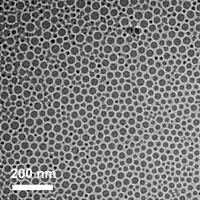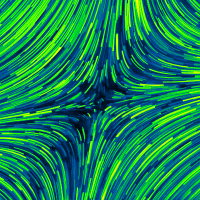Structured emulsion design and processing
Droplets exhibit unique behavior when driven to the nanoscale, i.e., when the range of colloidal interactions between droplets approaches their size. We have designed novel nanoemulsions to better understand this emergent behavior, and to harness it for the engineering of new materials with novel properties. Ongoing projects in this area include:
- Designing nanoemulsions with dynamically-tunable colloidal interactions
- Creation of complex nanodroplets for nanoparticle synthesis
- Assembly of nanodroplets into hierarchically porous structures

Biomolecular and colloidal assembly
Nanotechnology has opened up entirely new avenues for interfacing materials with biological systems. Significant advances in this area have been made by focusing on how material chemistry controls function and interactions. By contrast, our approach is to understand how mesoscale structure and properties can be used to impart new or enhanced understanding of biological systems. Examples include:
- Novel approaches to investigating protein assembly for biomaterial design.
- Probing non-classical effects in nanoscale nucleation and aggregation processes for biomineralization control.
Flow processing of complex fluids for structured materials
Industrial processing of soft materials involve a wide range of flow-processing histories that influence the material’s microstructure and, hence, plays a major role in the final morphology of the end-product. One of the grand challenges in soft matter processing is determining the connection between processing, structure and properties due to the plethora of design and processing parameters that need to be optimized. Towards this aim, our lab uses unique methods to understand this flow-structure coupling to enable the design of better flow processes for the production of novel soft materials. We focus particularly on complex flows, i.e., mixtures of shearing and elongation, to mimic realistic industrial flows. Examples of the some ongoing research in this thrust are:
- Nonlinear deformation of polymer solutions
- Effect of polymer topology on flow-induced scission
- Transient nature of coarcevate-precipitate transition in mixed polyelectrolytes due to mixing protocols
- Flow-induced phase transitions in self-assembled surfactants, lipids and coacervates

Tools to probe multi-scale fluid structure and dynamics
Inherent to the study of complex fluids is the need to characterize their structure and dynamics at a spectrum of length scales ranging from nanometers to several microns. To facilitate our research, as well as to serve the broader soft matter community, we continually develop and refine methods that give rich, multi-scale information about complex fluids. Click each link to learn more:
- Texture analysis microscopy: finding structural correlations in dense or low-resolution images
- Differential dynamic microscopy: sampling ensemble structural dynamics from video microscopy
- Flow environments for small angle scattering: in situ monitoring of nanoscale structure
